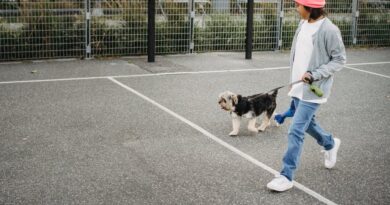How to Keep Your Dog Safe on Walks
Walking your dog is not only a great way to provide exercise and mental stimulation for your furry friend but also an opportunity for you to bond and explore the world together. However, just like any outdoor activity, there are risks involved when taking your dog for a walk. From traffic dangers to encounters with other animals, it’s essential to prioritize your dog’s safety during walks. In this comprehensive guide, we will delve into various aspects of keeping your dog safe on walks, providing you with valuable insights and practical tips to ensure a fun and secure walking experience for both you and your canine companion.
The Importance of Leash Training

One of the fundamental aspects of keeping your dog safe on walks is leash training. A well-trained dog that walks calmly on a leash is less likely to get into dangerous situations such as running into the street or approaching aggressive dogs. Start leash training your dog from a young age, using positive reinforcement techniques to encourage good behavior. Make sure to use a sturdy leash that is appropriate for your dog’s size and strength, and always keep it securely attached to your dog’s collar or harness.
Remember that leash training is an ongoing process, and consistency is key. If your dog tends to pull on the leash, consider using a no-pull harness or a head halter to prevent them from lunging forward. Additionally, practicing basic commands such as “sit” and “stay” during walks can help you control your dog in challenging situations.
Choosing the Right Walking Gear

When it comes to keeping your dog safe on walks, having the right walking gear is essential. Invest in a well-fitting collar or harness that is comfortable for your dog to wear for extended periods. Make sure that the collar is not too tight or too loose, as this can cause discomfort or pose a choking hazard.
In addition to a collar or harness, consider using reflective gear or LED lights to make your dog more visible during evening walks or in low-light conditions. This is especially important if you live in an area with heavy traffic or when walking near busy roads. A reflective leash and collar can help drivers and other pedestrians see you and your dog from a distance, reducing the risk of accidents.
Understanding Your Dog’s Body Language

Being able to read your dog’s body language is crucial for keeping them safe on walks. Dogs communicate through their body posture, facial expressions, and vocalizations, so it’s essential to pay attention to these cues to understand how your dog is feeling in different situations.
For example, if your dog starts to show signs of fear or anxiety such as cowering, tail tucking, or growling, it’s important to assess the situation and take appropriate action to remove them from the trigger. Similarly, if your dog displays signs of aggression towards other dogs or people, it’s essential to intervene calmly and redirect their attention to you using positive reinforcement techniques.
Avoiding Potential Hazards

When walking your dog, it’s crucial to be aware of potential hazards in your environment and take steps to avoid them. This includes being cautious around aggressive dogs, wildlife, toxic plants, and hazardous substances such as antifreeze or pesticides. Keep your dog on a leash at all times in unfamiliar or potentially dangerous areas, and steer clear of broken glass, sharp objects, or other debris that could harm your dog’s paws.
Additionally, be mindful of your surroundings and avoid walking near busy roads or construction sites where your dog could be at risk of getting hit by a car or injured by heavy machinery. Always stay alert and be prepared to react quickly in case of an emergency, such as a loose dog approaching or a sudden loud noise startling your dog.
Training for Recall and Emergency Situations
Training your dog to come when called is a crucial skill that can help prevent accidents and keep them safe on walks. Practice recall exercises in a safe and controlled environment, gradually increasing the level of distraction to ensure that your dog responds reliably no matter the circumstances. Use high-value treats and praise to reward your dog for coming back to you promptly.
In addition to recall training, it’s a good idea to prepare for emergency situations by teaching your dog basic first aid skills. This includes knowing how to stop bleeding, perform CPR, and administer medications in case of an accident or injury during a walk. Consider enrolling in a pet first aid course to learn essential lifesaving techniques and be prepared for any unexpected incidents.
Monitoring Your Dog’s Health and Wellbeing
While walking your dog is a great way to keep them physically and mentally stimulated, it’s important to monitor their health and wellbeing during and after walks. Pay attention to signs of fatigue, dehydration, or overheating, especially in hot weather or during strenuous activities. Bring water and a portable bowl to keep your dog hydrated, and take breaks in shady areas to prevent heat exhaustion.
Inspect your dog’s paws and fur for any signs of injury or irritation, such as cuts, bruises, or ticks, and address them promptly to avoid complications. Keep an eye on your dog’s behavior and energy levels, as sudden changes could be a sign of underlying health issues that require medical attention. Regular check-ups with a veterinarian can help ensure that your dog is healthy and fit for walks.
Conclusion
To wrap things up, keeping your dog safe on walks is a multifaceted endeavor that requires careful planning, training, and vigilance. By prioritizing leash training, choosing the right walking gear, understanding your dog’s body language, avoiding potential hazards, training for recall and emergencies, and monitoring your dog’s health and wellbeing, you can create a safe and enjoyable walking experience for you and your furry companion. Remember that every dog is unique, so adapt your walking routine and safety measures to suit your dog’s individual needs and preferences. By following the tips and guidelines outlined in this article, you can ensure that every walk with your dog is a fun and secure adventure.
Do you have any additional tips for keeping dogs safe on walks? Share your thoughts and experiences in the comments below!




